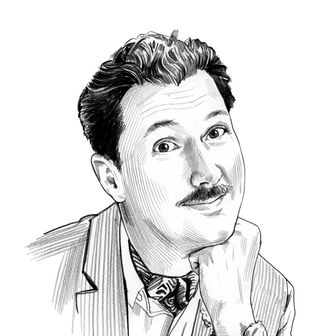
When I think about my favorite moment of America’s Next Top Model, which ends tonight after 13 years and 22 seasons (sorry, Tyra, “cycles”), I don’t think about that girl fainting or Tyra freaking out at Tiffany because she wasn’t serious enough when she got kicked off of the show. The moment that sticks with me is at the very beginning of the tenth season. All the prospective contestants were “enrolled” at a private “modeling” school and wearing sexy pleated skirts, knee socks, and navy blazers. They’re gathered around a stage on the football field waiting for the announcement of who is going to be the homecoming queen. They all think it’s going to be one of them, but it’s not. Of course not. It’s Tyra.
Tyra is not just any homecoming queen — she busts out of the paper background on the stage and has on a wig that is about as big as Mr. Jay’s hair-dye budget, with a tiara sloppily pinned on it. She’s wearing a gaudy bright yellow gown and, more importantly, has mascara purposefully streaming down her face. Tyra wants to look like a mess, like Carrie without the pig’s blood, because that is what Top Model is about: pure, outrageous ridiculousness. The best thing about it wasn’t the catchphrases, the crazy contestants, or the catty judges. Top Model’s biggest accomplishment was that it was the only reality show that ever understood camp.
Camp is a hard thing to explain (though Susan Sontag did an excellent job). You know it when you see it, like pornography or a really good weave. Essentially, it is a heightened form of irony — taking yourself incredibly seriously to a ridiculous degree or giving exaggerated importance to petty things. There is a level of sincerity that needs to be present, and if there is one thing that Tyra Banks has in more abundance than forehead, it is sincerity.
My favorite examples of this are Tyra’s introductions to seasons eight through 13, where she would kick off the festivities each season by making a ridiculous spectacle out of her arrival before choosing the final contestants for the season. She treated the choosing of these girls as if they were going to be the next ambassador to the U.N. or like they were being awarded a MacArthur Grant, when really, they were being picked to be on a reality-television competition where the photo shoots included spiders on girls’ faces and dressing up as fairy-tale characters and then falling off a ledge. For season nine, Tyra performed as a showgirl aboard a cruise ship; for season 12, she dressed as a Greek goddess at Caesar’s Palace in Vegas; and, saving the best for last, for season 11, she and the two Jays dressed like they were alien robots from the future here to take the girls back to their home planet of Fabulon, or some such nonsense. They even “beamed into” the judging room, with special effects that looked like a cable-access show was given a $10,000 budget.
After the first couple of seasons, when it became clear this show wasn’t going to be regularly landing girls on the runways in Paris or the covers of Vogue, it decided to stop targeting legitimacy, while taking itself completely seriously at the same time. Tyra was bigger and more popular than the industry that spawned her. She seemed to believe she was changing these girls’ lives for the better and teaching them to be better people — but she was really just giving them ridiculous extensions and a couple of good stories before shuttling them back to obscurity.
That insistence that the girls have a great sense of purpose never meshed with exactly how stupid the challenges on the show really were. There was never going to be a fashion show where the models swirled down the runway as coached by two identical men who look like a gay version of Blackula, and there certainly wasn’t going to be one where they carried tiny little cockroaches on blinged-out leashes. But here they were, doing it as if their dreams depended on it.
The disconnect between what was happening on the show and what was going on in the real world of fashion was where the camp was mined, and where all the fun was had. We all see billboards, magazine ads, and fashion editorials regularly, and we know they never look like the hokey-themed extravaganzas that the ANTM crew planned, like the one where all the girls portrayed different issues of the day like “animal rights” or “airport security.” Never once has Christy Turlington had to make a rap video incorporating the lyrics “Pot Ledom, top model backwards” and co-starring Tyra Banks wearing a fuchsia boa and a weird little person. That’s not even a joke from a Stefan skit. That is a real thing that happened on the show.
Even after season 14, when Tyra stopped doing her amazing, over-the-top introductions and enlisted André Leon Talley and Vogue Italia to unsuccessfully try to class up the joint, we knew the girls weren’t really competing for all that much other than $100,000, their very own Wikipedia page, and maybe the chance to do a psoriasis-drug commercial a decade after their win.
On American Idol, contestants actually go on to reasonably lucrative recording careers; on Top Chef, they routinely open successful restaurants. As a result, when Ryan Seacrest or Padma Lakshmi tell the contestants their lives could change, we believe them. That was never true on Top Model, a show devised around a career that many think requires no skill other than winning the genetic lottery. Though “smizing” is harder than you realize, success as a model requires as much skill as being born. That is why it had to be camp in order to survive and prosper.
America’s Next Top Model was about modeling in the same way Call of Duty is about enlisting in the military: They both provide a harmless simulacrum for our entertainment where we can experience the thrill of battle without the whir of flying bullets. No one ever watched Top Model to get an insider’s view of the fashion industry — we watched it to see a bunch of desperate girls who weren’t there to make friends try to live out their luxurious dreams for a fortnight before returning home with a new hairstyle and a portfolio full of fading images. We watched because they would be forced to walk in sky-high heels down a runway that inexplicably had swinging pendulums across it, as if that is a thing that happens in the real world. We watched because it was poking fun at its own seriousness without even knowing it. That is camp. That is brilliant. And that, most of all, will be missed.


